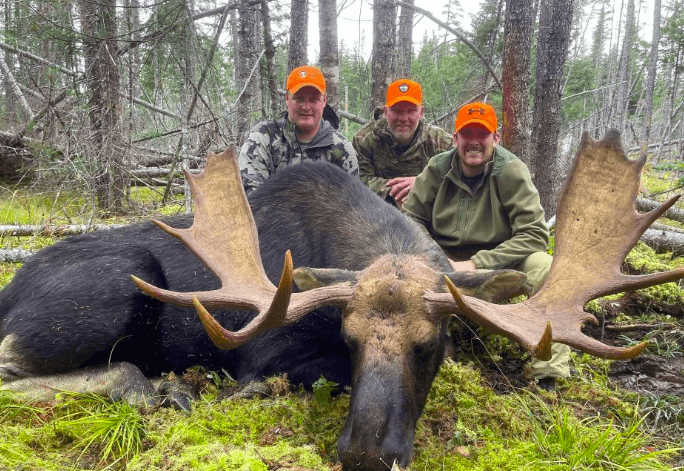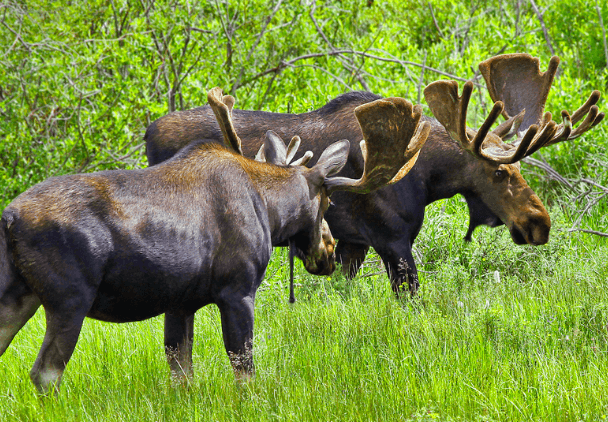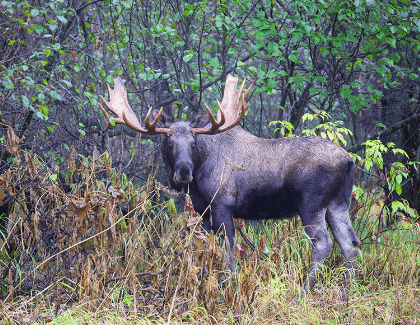
Vermont Moose Hunting
Vermont’s huge wilderness regions and robust moose population provide an exciting opportunity for moose hunters. Moose hunting in Vermont is strictly controlled and carefully managed to maintain the population’s survival while also providing a unique hunting experience.
In this introductory guide, we will look at the most significant parts of moose hunting in Vermont, such as licensing, seasons, hunting tactics, and vital factors to consider for a successful and ethical hunt. Vermont is famous for bear hunting and deer hunting.
Whether you’re a seasoned hunter or just starting out, Vermont’s moose hunting chances will provide you with wonderful experiences in the middle of its stunning landscapes and rich animals.
Vermont Moose Hunting Seasons Explained:

Moose hunting seasons in Vermont are eagerly anticipated and meticulously controlled to maintain the long-term conservation of the moose population. The following is an explanation of Vermont’s moose shooting seasons:
Lottery Season:
For moose hunting permits, Vermont uses a lottery method. Hunters must apply for a permit during the application period, which is usually in the spring. Successful applications are chosen at random in a lottery draw.
Archery Season:
The moose archery season begins in early autumn, generally around late September. Bow and crossbow hunters can pursue moose with bows and crossbows. This season offers a one-of-a-kind and tough hunting experience.
Regular Season:
The regular moose hunting season occurs in the late fall, usually in October. This season allows hunters to pursue moose using firearms, including rifles and shotguns. It is the primary hunting season for moose in Vermont.
Season Duration:
The Vermont Fish and Wildlife Department establishes the dates and lengths of the archery and regular seasons. Season duration might vary from year to year depending on population and management objectives.
Moose Hunting locations Vermont.

Vermont has a number of moose hunting areas spread out across the state. Here are some popular moose hunting areas:
Northeast Kingdom Region:
This area, which includes Essex, Orleans, and Caledonia counties, is recognized for its deep forests and abundant moose habitat. Massive stretches of public property, including state forests and wildlife management zones, offer outstanding moose hunting possibilities.
Green Mountain National Forest:
The Green Mountain National Forest, which is located in central and southern Vermont, encompasses a large area of the state. For those prepared to explore its wide wilderness, this large wooded area offers different moose habitat and various hunting options.
County of Chittenden:
Chittenden County, located in northeastern Vermont, is home to numerous major wooded regions, including Mount Mansfield State Forest and Camel’s Hump State Park. These locations, particularly on the outskirts of wooded areas, offer suitable moose hunting grounds.
County of Bennington:
Bennington County, located in southern Vermont, has varied forests and steep terrain, making it an appealing region for moose hunting. Green Mountain National Forest and nearby woodlots provide hunting possibilities for individuals in the area.
County of Grand Isle:
Grand Isle County, located in the northern section of Lake Champlain, offers unique moose hunting possibilities in marsh regions and the lake’s coast. It should be noted that entrance to hunting areas in this county may require authorization from.
Wildlife Management Areas (WMAs):
Vermont’s wildlife management areas, such as Victory Basin and Holland Pond, may be suitable for moose hunting. These locations are maintained to improve animal habitat and can be productive moose hunting fields.
Remember to check the Vermont Fish and Wildlife Department’s hunting laws and maps for particular hunting zones, access points, and any other guidelines or limits for moose hunting in these locations. It’s also a good idea to seek local expertise, talk to wildlife experts, or connect with hunting communities for the most up-to-date information on moose numbers and suitable hunting areas.
How to hunt Moose In Vermont: Full Guide
Moose hunting in Vermont involves meticulous planning and preparation. The following are the general processes involved in moose hunting in Vermont:
Regulations and research:
Familiarize yourself with the moose hunting laws of the Vermont Fish and Wildlife Department, including season dates, permit requirements, hunting zones, bag limits, and particular rules and limitations. Obtain all required licenses and permissions.
Scouting and Locating Moose:
Conduct extensive scouting visits in the locations where you intend to hunt. Tracks, droppings, rubs, and browse are all evidence of moose activity. Identify probable moose habitats and travel patterns using maps, trail cameras, and local knowledge.
Obtain a Moose Hunting Permit:
Enter the moose hunting permit lottery by submitting your application during the specified period. If you are chosen, the Vermont Fish and Wildlife Department will notify you and give you with information regarding your permit, including the Wildlife Management Unit (WMU) and permit type.
Preparation and planning:
Prepare your equipment, which should include proper rifles, ammo, optics, and hunting equipment. Make sure you have appropriate attire for the weather, sturdy footwear, and necessary supplies. Plan your hunting plan, taking into account access locations, hunting techniques, and safety considerations.
Preseason Scouting:
Conduct additional scouting excursions as the hunting season approaches to monitor moose movement patterns, identify suitable hunting areas, and acquire up-to-date information on moose behavior and habitat usage.
Methods of Hunting:
Vermont authorizes moose hunting tactics such as spot-and-stalk, calling, and still-hunting. Choose a method that is appropriate for your talents and the terrain you will be hunting in. Each strategy takes patience, subtlety, and understanding of moose behavior.
Ethical and Responsible Hunting:
Use ethical hunting techniques such as fair chase principles and only taking responsible shots. Know the anatomy of a moose and target crucial organs for a swift and humane slaughter. Keep all applicable laws and regulations in mind.
Dressing and processing in the field:
After successfully harvesting a moose, field dress it immediately to chill the meat and maintain its freshness. Have the required equipment for field dressing on hand, as well as a strategy for moving the meat out of the field. Seek help if necessary.
How can I get a moose hunting permit in Vermont, and what are the tags?

You must enter the yearly moose hunting permit lottery to get a Vermont moose hunting permit. Here’s a rundown of the procedure:
Application:
The moose hunting permit lottery in Vermont usually begins in the spring. You must submit your application during the application period. The Vermont Fish & Wildlife Department’s website has the specific dates and application details.
Lottery Results:
Following the application period, the successful candidates for moose hunting licences are chosen at random. The amount of licenses available fluctuates from year to year and is determined by management objectives and demographic projections.
Successful Applicants:
The Vermont Fish and Wildlife Department will notify you if your name is drawn in the moose hunting permit lottery. The notification will include information about your Wildlife Management Unit (WMU), permit type, and any extra regulations or limitations that apply to your permit.
Types of Permits:
Vermont provides a variety of moose hunting licences, including bull-only and antlerless permits. The particular rules surrounding the moose you are permitted to collect will be determined by the type of permit you acquire.
Moose Hunting Tags:
You will receive moose hunting tags along with your moose hunting licence. These tags must be fitted to the harvested moose immediately after the kill and must stay on the moose until it is processed.
It’s worth noting that the moose hunting permit lottery is accessible to both Vermont citizens and non-residents, albeit non-resident licenses are limited in quantity.
Reporting and Tagging:
Report your moose harvest to the Vermont Fish and Wildlife Department within 48 hours following a successful harvest. Follow the exact instructions supplied with your permission to correctly tag the harvested moose with the designated moose hunting tag.
Remember that moose hunting restrictions in Vermont might vary from year to year, so study the official Vermont Fish and Wildlife Department’s hunting regulations and remain up to speed on any changes or extra requirements before beginning on your moose hunting excursion.
Each year, the Vermont Fish and Wildlife Department publishes full information on the application process, permit fees, and any regulatory changes.
For the most up-to-date and accurate information on the moose hunting permit application procedure in Vermont, visit their official website or contact the department directly.
Moose hunting Vermont Tags
- Resident Moose Hunting Tag: $100
- Non-Resident Moose Hunting Tag: $350
Please note that these prices are subject to change, and it’s important to refer to the official Vermont Fish and Wildlife Department’s hunting regulations or their website for the most up-to-date and accurate information regarding moose hunting tag fees in Vermont.
FAQs Answered:
Here are some commonly asked questions (FAQs) and answers concerning moose hunting in Vermont:
Q: How can I apply for a Vermont moose hunting permit?
A: In order to apply for a moose hunting permit in Vermont, you must first enter the annual moose hunting permit lottery. Applications can be filed online or by mail during the official application time, which is usually in the spring, via the Vermont Fish and Wildlife Department’s website.
Q: Are non-residents permitted to shoot moose in Vermont?
A: Yes, non-residents can enter the moose hunting permit lottery and hunt moose in Vermont. Non-resident permits, on the other hand, are limited in quantity and are subject to additional expenses.
Q: What is the moose hunting bag limit in Vermont?
A: The moose bag limit in Vermont is established by the laws connected with your hunting permit. A permit typically permits for the harvest of one moose, either bull or antlerless, as stipulated in the permission.
Q: What methods of moose hunting are permitted in Vermont?
A: Spot-and-stalk, calling, and still-hunting are all legal moose hunting tactics in Vermont. Hunters can select a technique according on their talents, terrain, and preferences.
Q: Are there any antler limitations in Vermont for moose hunting?
A: Yes, Vermont has the authority to impose antler limits based on management objectives and population dynamics. These limits can change from year to year and may apply only to certain hunting zones or permit categories. For any antler limitations, it is critical to examine the regulations linked with your permit.
Q: Are there any dress restrictions for moose hunters in Vermont?
A: There are no special dress regulations for moose hunters in Vermont. However, it is essential that you dress appropriately for the weather, including blazing orange for safety during firearm seasons.
Q: Can I shoot moose in Vermont as part of a group or as a party?
A: Yes, hunters in Vermont can shoot moose in groups or parties. However, each hunter must have a valid moose hunting permission, and all hunting operations must adhere to the restrictions and bag limitations established for each permit.
Q: What should I do after a moose hunt in Vermont?
A: After killing a moose, you must immediately field dress the animal to allow the flesh to chill. Ensure that the moose is correctly tagged with the designated moose hunting tag and that the harvest is reported to the Vermont Fish and Wildlife Department within 48 hours, as required.
Related post.
- Bear Hunting Vermont; A Comprehensive Guide.
- Exploring the Wilderness: Deer Hunting in Vermont’s Breathtaking Landscapes.
- Deer Hunting in Connecticut: A Guide to Seasons, Regulations, and Tips.
- Exploring Pronghorn Hunting States and Their Tags: A Comprehensive Guide.
- Elk hunting Canada. How and Where can you Hunt elks in Canada.






